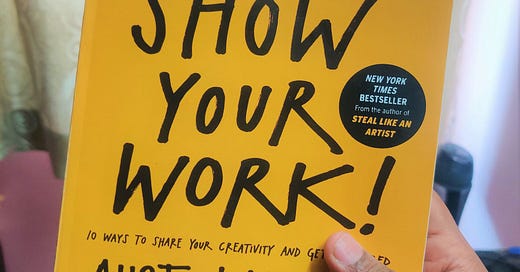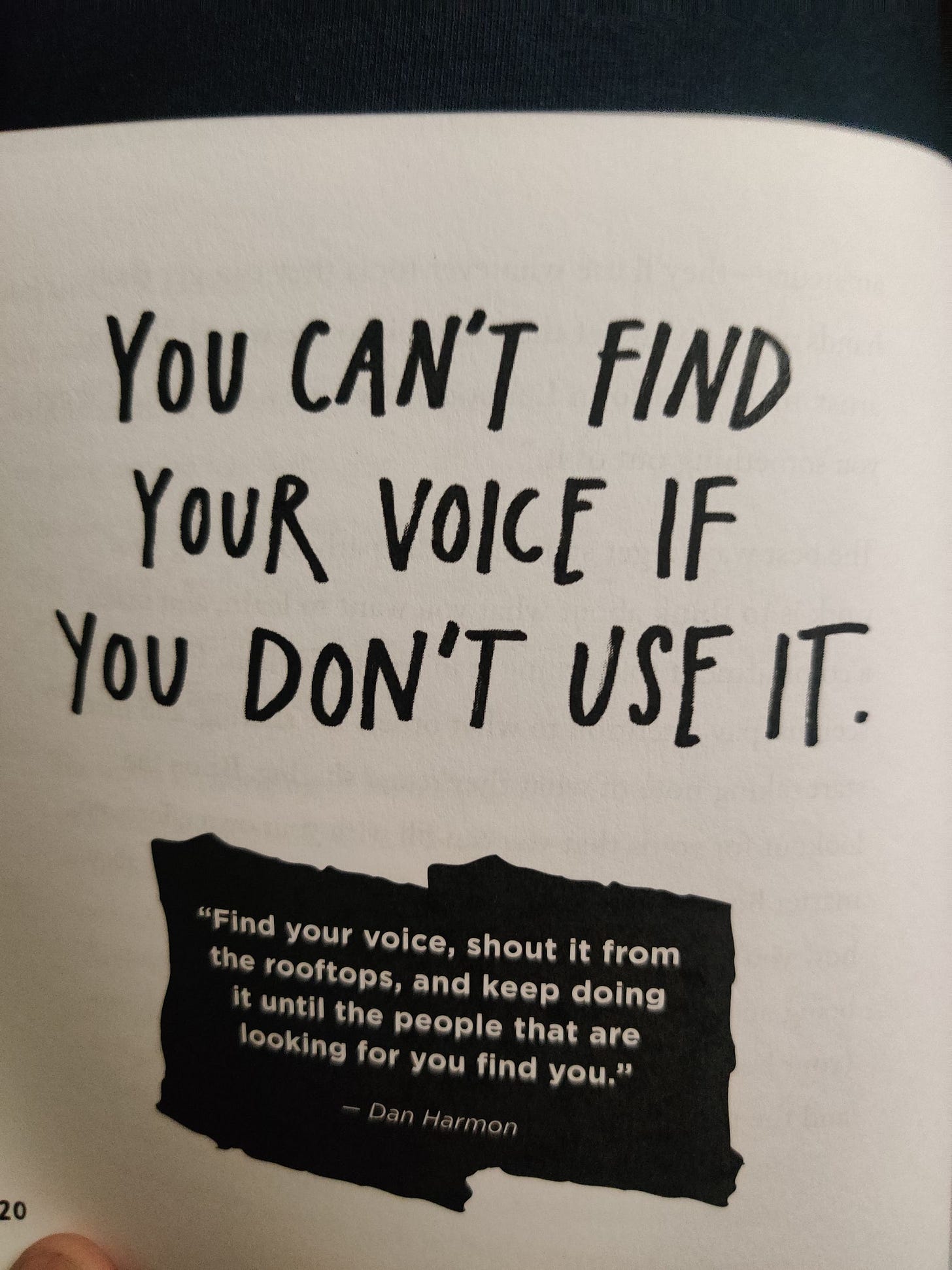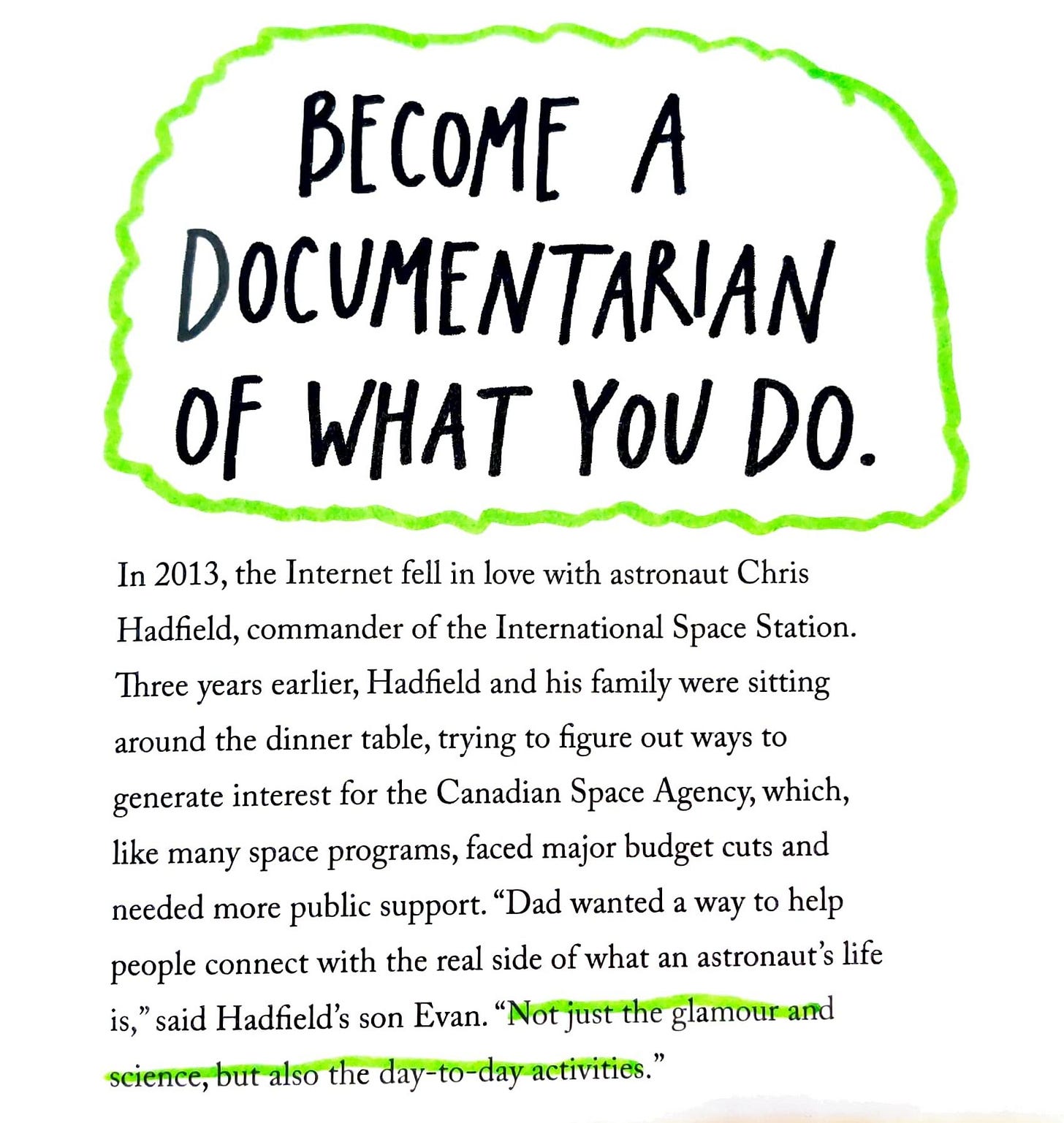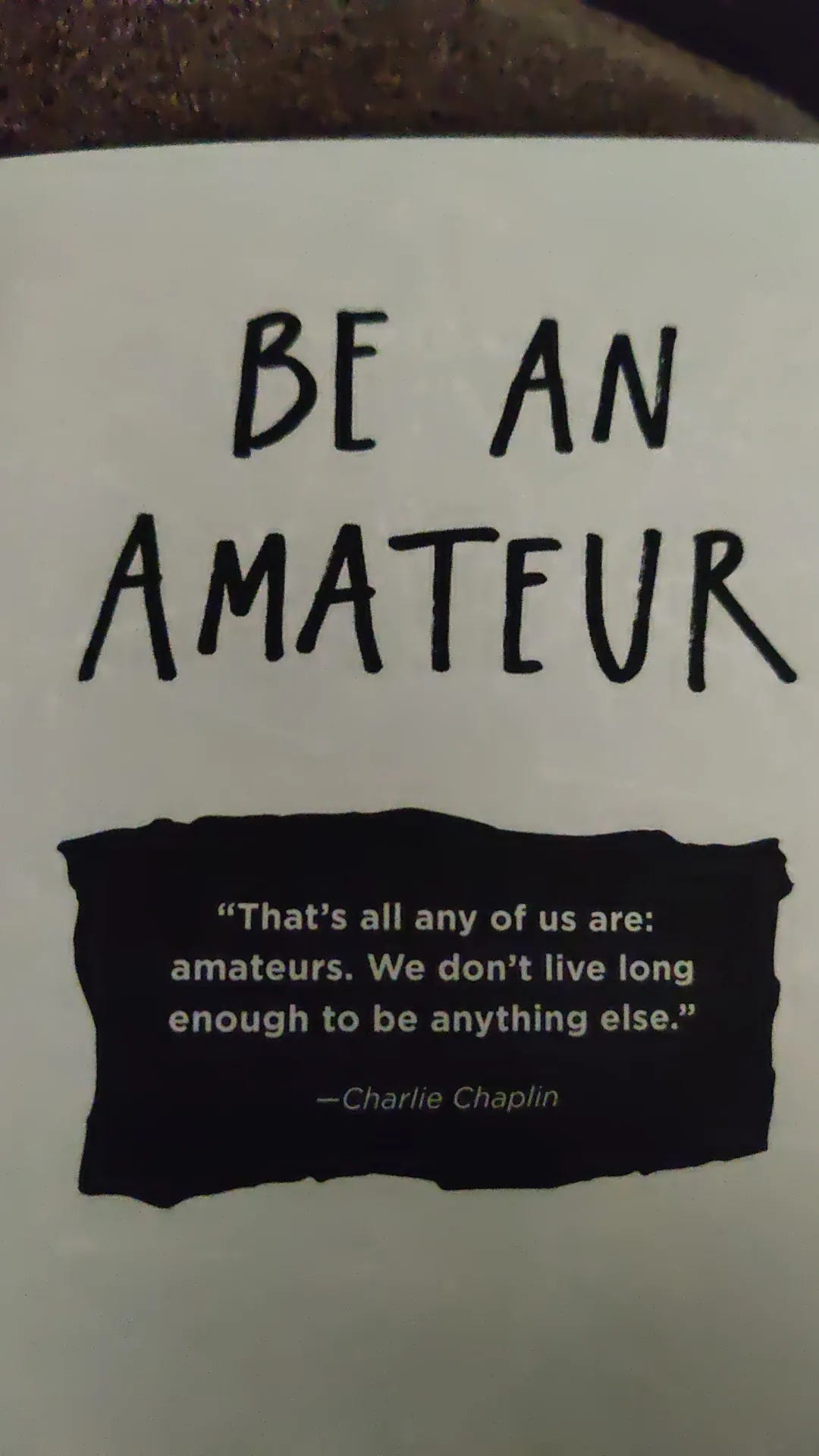Show Your Work
Book Summary + Notes - 10 ways to share your creativity and get discovered.
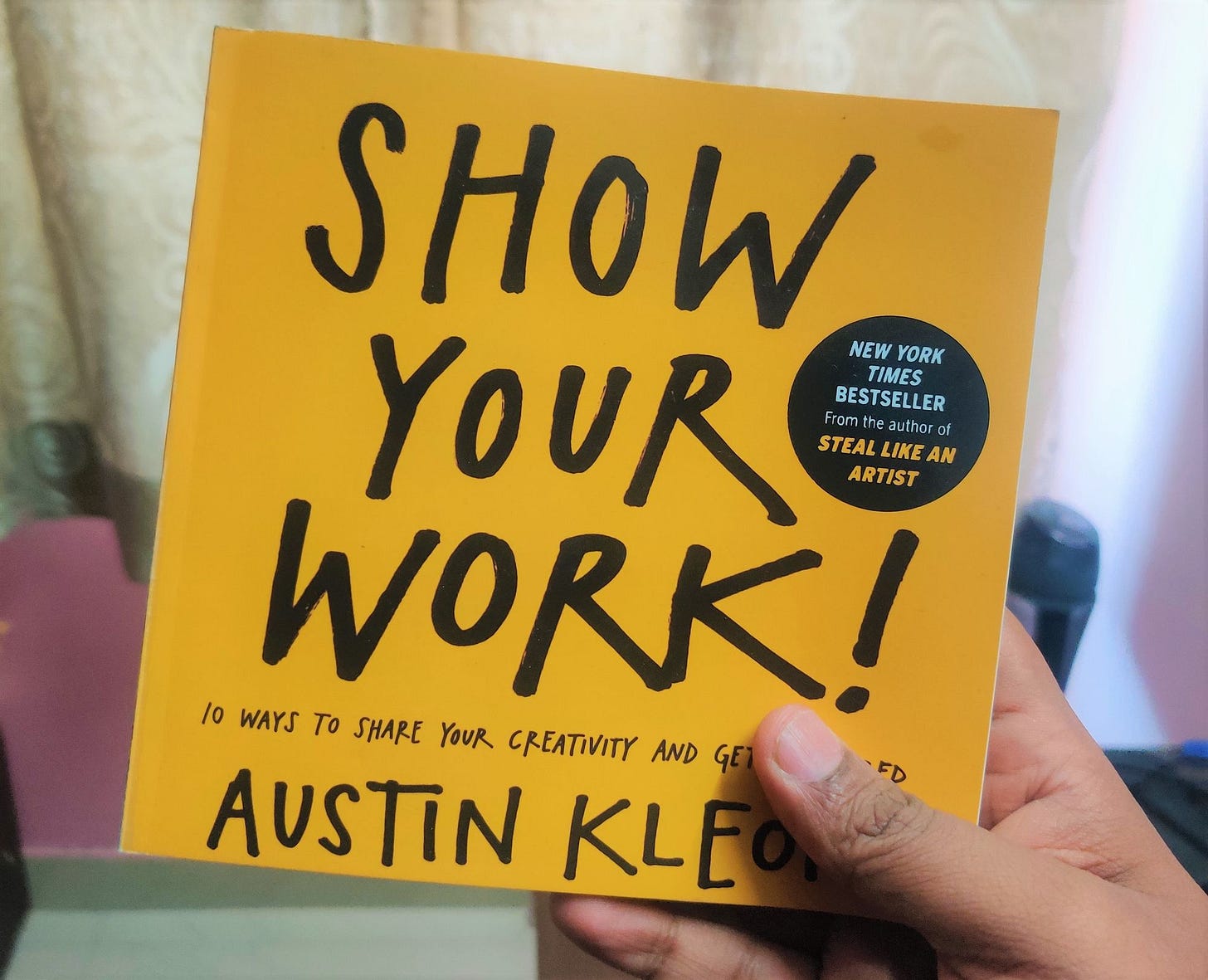
Show your work is a book written by Austin Kleon which was originally published on 6 March 2014. This book is a follow up to the book ‘Steal Like An Artist’ where he writes about how we all can “steal” in a noble way while being creative. In this book, Austin Kleon shares his ideas on how one can show their work and share their work online even though some people hate the idea of self-promotion.
I first heard the book Show your work by the same author last year in lockdown from Ali Abdaal's channel. I was looking about him(Austin Kleon) online and then found out that he has a 3 part book on being creative. That is when I purchased Steal Like An Artist book first. After that, I was interested in reading the rest two books of the series in paperback because of the illustrations and his style of writing which adds so much to our reading experience.
💡 If you want to read the summary of steal like an artist to learn more about the book before deciding to purchase and read it. You can read it here: Steal Like An Artist Summary
🤔 Why did the writer write this book?
This book is written as a follow-up to the book Steal Like An Artist and it makes sense because think about it. If you have an idea, what would you like to do? You would like to share it with someone right!!!!
Austin Kleon describes the book as -
A book for people who hate the very idea of self-promotion, Show Your Work! is the follow-up to my New York Times the bestselling guide to creativity, Steal Like An Artist. If Steal Like An Artist was a book about stealing influence from others, Show Your Work is about influencing others by letting them steal from you.
🤷♀️ What is the book about?
This book is a realistic way of sharing your work with the world. This book breaks all the misnomers around self-promotion and gives you 10 ways to share your creativity and get discovered.
This book will teach you how to be sharing your work, how not to be sharing your work, and lastly, how long should you be sharing your work (Hint: it’s until the day you decide to stop being creative).
Most people who first take the book wonder whether this book will be any good because you are not a creative person. Well, I would ask you to take it home and read it! because this book although shares strong facts for creatives, it does applies to anyone to live a better life.
📚 Book Notes and summary
You know the first page after the table of content or index is this quote -
For Artists, the great problem to solve is how to get oneself noticed - Honoré De Balzac
This book tries to solve the exact problem many artists and creatives face which is how to get oneself noticed. Austin shares his knowledge of sharing your work in 10 ways. Each way brings out one different aspect of sharing ideas and more.
You Don’t Have To Be A Genius
Think Process, Not Product
Share Something Small Every Day
Open Up The Cabinets Of Curiosities
Tell Good Stories
Teach What You Know
Don’t Turn Into Human Spam
Learn To Take A Punch
Sell Out
Stick Around
The Internet has made a very interesting way for people to work and be more open about their Journey and this is what Author Austin Kleon talks about in these 10 points. He likes to believe that the online presence is important because you don’t find an audience for your work. They Find You.
You Don’t Have To Be A Genius:
The whole idea that people who are genius at something can only share something or contribute something to others is gone. If you think about what I possibly have to share - You are not alone and here is a simple way - Find Your Scenius.
Scenius means being part of a group of people sharing the same collective ideas. It can be your reading clubs, your group of friends who talk about Web3, or someone interested in a particular way of living that will make them feel creative. Thanks to the Internet, you don’t have to look around to find these Scenius. it is available in the form of forums, and groups on Social media.
You can start by learning one new thing capturing that idea and then adding your ideas along with it as a thought experiment.
There is this old saying that you can learn from an amateur than from a master.
Austin explains that a beginner in the process of doing things unprofessionally will make a discovery.
Talk about things you love. Your voice will follow.
Think Process, Not Product:
The process is always messy which is the reason why most viewers need the result, the finished product. Whereas the process is for you and you alone. It is your discoveries of doing the work and finding new insights, making mistakes, that shape the artwork that excites you. So, if you share your process, you will form an ongoing connection with people which indirectly moves our product.
Become a documentarian of your work. Whatever the nature of your work is, there is an art to what you do and there are people who would be interested only if you present it in the right way.
Share Something Small Every Day:
Sharing something small every day is just this one piece of advice that resonated with me:
If you’re in the very early stages, share your influences and what is inspiring you. If you are in the middle, write about what you learned and how you implemented it. If you have tons of work already in the world, share the interactions of people with your work and the reports.
Also,
Don’t let sharing your work take precedence over actually doing your work.
Another piece of information that he shares in this book which completely makes sense if you are someone who takes notes is -
The thing about Keeping notebooks is that you have to revisit them to make the most out of them. This line hit me hard because I always try to write notes so I can share some of the best in my newsletter and also have a place to refer but never do that. It is not until I go back and link these that I find patterns and new ideas.
Now, you might be wondering where can you share your small pieces of work every day.
The author suggests building a domain on the internet. If you register for a www.[yourname].com and share your smallest learnings every day. In the future, it will help you have enough ideas under your belt to be able to look back and see what you have learned.
Open Up Your Cabinet Of Curiosities:
In the 16th and 17th century Europe, it was fashionable to have a wonder chamber or a cabinet of curiosities, that is a room filled with rare and remarkable objects subjective to them.
Similarly, we can even have our cabinet of curiosities. It can be our favorite books, movies, novels, music, artists, places we have been, places we want to be, and people we met. This will encourage you to write about the things you care about.
Most people see that reading and writing as the opposite ends of the same spectrum but your reading feeds your writing.
So, having a place where you share your influences, your travel, your thoughts, and more will open up the curiosities of others and yourself.
He also mentions that if you find things you genuinely enjoy, don’t let anyone else make you feel bad about it. Celebrate them.
When being open about your interests and influences Credit is always due. In the internet age, attributing others’ work is the only way people can look for more of their work and explore their curiosity.
Attribution is all about providing context for what you are sharing.
Don’t share things you can’t properly credit. Find the right credit or don’t share.
This line resonated a lot from this segment because, in my newsletter, I share the interesting content I have come across in the week, and sometimes, I don’t find the right credit. I don’t know where to look for next to learn more about.
So, I practice crediting properly in my newsletter. If you are a reader, you must be seeing the links to the writer, the tweeter, and the video creator. It is only to give you a place to explore.
Tell Good Stories:
When shown an object or a project, people assess it based on how much they like it, and how valuable it is. This all can be deeply affected by what you tell them about it.
Words Matter. We all want to know where things came from, how they are made, and who made them. Unknowing we tend to find the answer to these not only in books but in all the products we see and like.
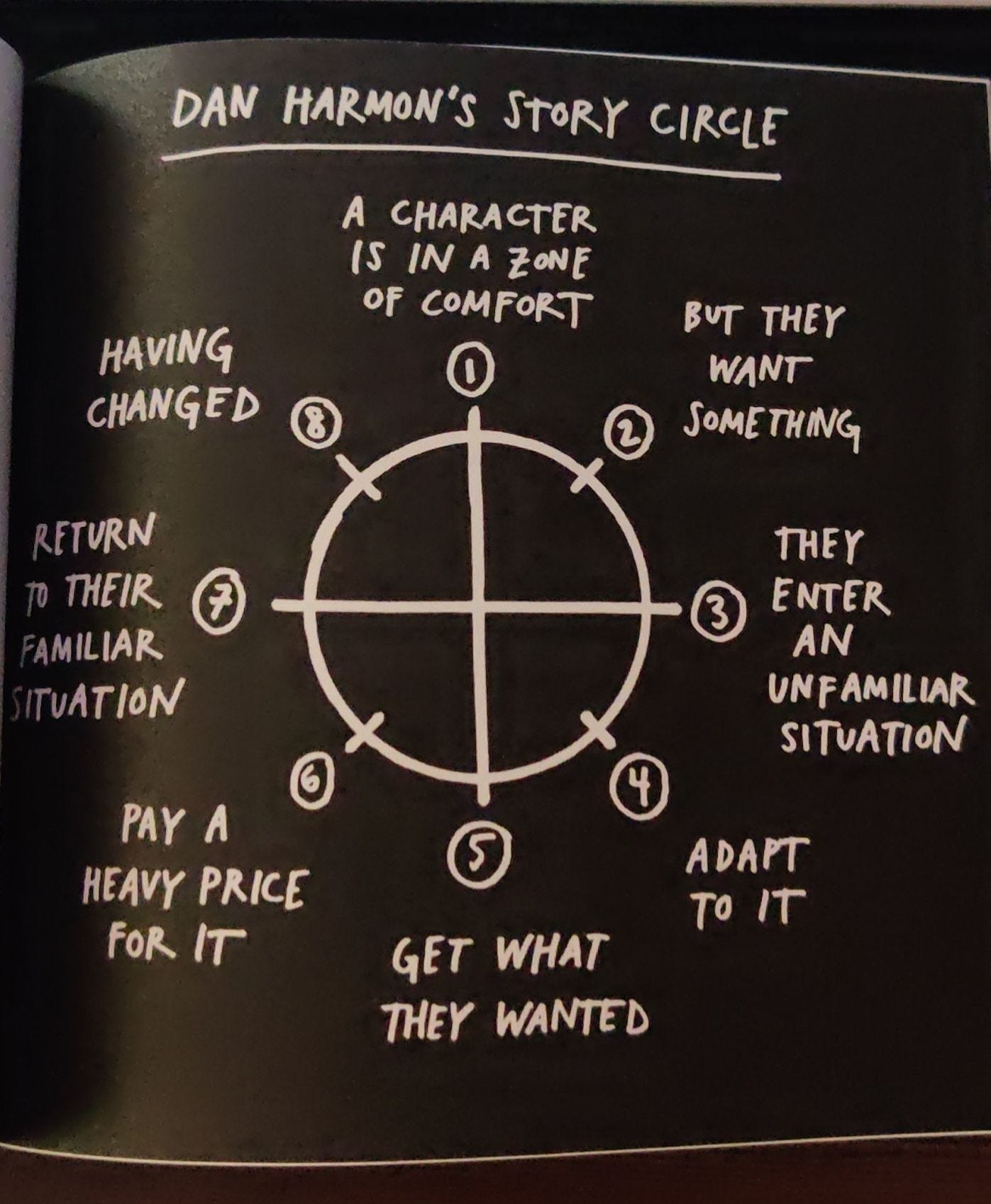
So, telling a good story will matter when showing your work. It may be a finished or unfinished story always keep the audience in mind. Value your audience’s time. Learn to speak. Learn to Write.
Another thing I took from this segment is how he mentions talking about yourself at parties. Don’t be shy to say you do this. So, from now on, if anyone asks I will be telling them I am a writer while working full time. It should be easy to understand people what you do.
Teach What You Know:
This is simple. I wrote my notes from this segment into the following points:
Think about what you can share from your process that would inform people you are trying to reach.
The minute you learn something, turn around and teach it.
Make people better at something they want to be better at.
Create Tutorials and take people step by step through part of your process
Use Pictures, words, videos, and inspirations you find along the way.
These points sum up how you can even break down your creative work and find relevant resources to share with your audience.
Don’t Turn Into Human Spam:
In the spectrum of creating and sharing with people, be a contributor, a curator, and a great open node rather than being all about you.
Share other people’s work, and appreciate them openly if you like their work. If you want fans. Be a fan first. In other words, if you want to be interesting be interested in others' work as much as yours.
While sharing such works of people you like, you will come across people who share the same interests as you and share a similar mission to yours. Keep such people as close to you as possible.
Learn To Take A Punch:
When you put out your work, you have to be ready for the good, the bad, and the ugly.
You have to be ready to take in any comments that come your way.
Whose feedback do you care about then?
It should be from the people who share the same mission as yours. It should be from people who care about you and your work.
The best way to take a punch is:
Relax and breathe: Fear is often the imagination taking the wrong turn
Strengthen your neck: The more criticism you take, the more you realize it can’t hurt you.
Roll with the punches: You can’t control what sort of criticism you get, but you can control how you react to it.
Protect your vulnerable areas: Keep the work that you feel is too close or too sensitive. Keep it hidden.
Keep your balance: You have to remember that your work is something you do, not who you are.
Sell Out:
Some of the most meaningful and cherished work was made for money. This is the thing you need to understand. No work can be done for free. If you have your friends win something will you be happy for them or will you be removing them from your friends list?
Be proud of your friends' work as much as your success.
Everybody says they want the artists to make money but when they do. Everybody hates them for it. It’s just the way it is.
Think about it. If you see a struggling actor make it big. Are you genuinely happy for that actor or call him lucky?
If you want to find out how people can be part of your sell-out. Be open about your process, connect with your audience, and ask them to support you at the end. If you have a website, add a donation button. Similar to musicians passing around the hat during the concert. It is for people who enjoy your work.
😋 I do have a donation button in case you are looking to buy me a coffee, books, or better equipment 😜 - Hint: it’s here and on the footer named “Donation”
In this section, he also recommends everyone that everyone must keep a mailing list. He explains the most boring and utilitarian technologies are the ones that stick the longest. Email is one such technology. I recently shared some notes from Benedict Evans in my newsletter. The better reason is if you are part of it, you definitely have to go through the trouble of deleting the contact.
Some important points to remember while building a mailing list:
Be clear about what they can expect
Let them know the frequency by which the mail will be reaching their inbox.(daily, weekly, monthly, infrequent)
Lastly, never add someone’s email address without their permission.
Keeping yourself busy is an absolute way to constantly adapt to change as Walt Disney says -
We don’t make movies to make money. We make money to make more movies.
The last thing he talked about in this section is that there will be a switch from saying yes to opportunities to saying no. This is not because of the work you do, but to pay for the work you do. To understand better, the biggest problem of success is that the world conspires to stop you from doing the thing that you usually do.
The point to remember is You just have to be as generous as you can, but selfish enough to get your work done.
Stick Around:
These words from Orson Welles -
If you want a happy ending, it depends on where you stop your story.
You can’t be happy with being a master. You will look for things to be an amateur. So, keep your curiosities open, and don’t be afraid to learn a lot of things.
Look for something new to learn, and when you find it. Learn it out in the open. Document your progress and share as you go so that others can learn along with you.
Show your work and when the right people come along they will have a lot to show you as well.
Stick around for a step longer, if you don’t feel like it. If you do not like the topic you are learning for a month, stick around for a week more before you completely confiscate it and not learn it again.
✒ My Top 5 Quotes
This book has amazing quotes from other creators but here are 5 quotes that are worth reading and re-reading:
In order for connection to happen, we have to allow ourselves to be seen, really seen - Brené Brown
Become a documentarian
If you work on something a little bit every day, you end up with something that is massive - Kenneth Goldsmith
Don’t share things you can’t properly credit. Find the right credit or don’t share
Feel free to take what you can use, and leave the rest. There are no rules.
🛒 Where can you buy the book?
This book is available on Amazon for which you can find the links below:
You can find more of the work from Austin Kleon here. I highly recommend checking out his work. He has a newsletter where every Friday since 2013🤯🤯🤯, he has been sending out 10 things worth sharing with his subscribers and I love the collection he must be having. I read more about his work online from anywhere possible and you must as well. This summary is one of my attempts to let you know about this amazing book and the writer.
Subscribe to his newsletter wherein the free version he shares 10 things from the week that are worth sharing. Subscribe below. I promise you will find interesting reads, every week. I am subscribed to this newsletter and I enjoy this newsletter a lot.
🔚 Conclusion:
This book is a great read for someone who is second-guessing themselves on whether to take the step of sharing their work. It is focused on creators but not every work needs some creativity.
As the author suggests take advice that you can use and leave the rest.
I would one hundred percent recommend reading this book and the previous book Steal Like An Artist before starting your creative journey. This is a book that needs to be read at least once and even more if you are looking for ways to be creative.
Thank you for reading.

